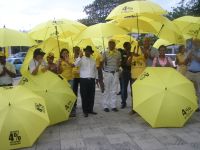DOMINICAN REPUBLIC: Four Percent for Education

The government of the Dominican Republic, where one-third of the population of is under 14 years of age, is facing a well- organised and growing citizens' campaign to increase the amount spent on public education.
The current budget calls for spending of 1.3 billion dollars, which is only 2.4 percent of the gross domestic product of the nation. According to a law passed in 1997, four percent of the GDP is to be allocated to education.
The Dominican Republic spends much less on public education than most countries in the region. Cuba spends the most in the hemisphere at 18.7 percent, El Salvador spends eight percent, Jamaica spends 6.1 percent, Mexico 5.3 percent and Costa Rica 5.1 percent. In this hemisphere, only Haiti at 1.4 percent and Ecuador at one percent spend less on educating their children.
The campaign was launched by various civic groups and is aided by advertisements featuring local celebrities urging people to come out for various protests, wearing something yellow. Large yellow umbrellas with '4 percent 'printed in black are displayed on balconies around the capital. An increasing number of cars sport the bright yellow bumper stickers.
At four p.m., on the fourth of each month, supporters are asked to assemble, wearing something yellow, at various points in the country. On Wednesday this week, some of the protestors were removed from the entrance of the opening of a two-week book fair, one of the main events in the capital.
Earlier, at the scheduled four p.m. time of assembly, a protest group stood on the sidewalk opposite the National Palace.
'We here to demand that the government comply with the law of spending four percent of the gross national product on education,' Diomedes Mercedes, an attorney, told IPS. 'So on the fourth of each month, at four p.m., we are going to stand here in front of the Palace to remind them that the people want this. We will be here until they fulfill their promise. We have been here every month since January. Last year, we gathered every month until November. '
'There are too many people here who do not have access to education,' he said. 'And even for the ones that do have access, much is missing. We have been fighting for three years for a decent level of development here in this country.'
Many of the organisers and civic groups behind this action came together two years ago to fight the government's plans to grant a lease within the national park on the Samana peninsula, Los Haitiese, to a private local company to produce cement. The group that came together represented both young and old, and crossed educational and class lines. Many who participated said that they had never before seen a similar convergence.
In the end, the cement factory was defeated but the coalition remained in place.
Mercedes was part of the protest that saved Los Haitisese.
'We have a certain authority in the country now,' he said. 'And we are putting it to the service of the cause of education, which is not only a law but also something that is necessary for our development. We believe that we will be successful because we are expressing a national sentiment. Polls have shown that 94 percent of the people in this country support the four percent.'
The president of one of the major organising civic groups 'Toy Harto pero Creo en Mi Pais' (I am fed up but I believe in my country), Elizabeth Mateo Perez, is a former student leader and attorney who worked for the Supreme Court.
Behind the public face of the protests, Toy Harto is pressing a lawsuit with 1,078 named plaintiffs — including the entire Senate and Congress - for failing to comply with the law requiring four percent for education when they passed the latest budget.
Standing under a bright yellow '4 percent' umbrella in the light drizzle, Perez explained why the increase in the budget is needed.
'We are missing 11,000 classrooms, [and] many of the classrooms which we do have are overcrowded,' she told IPS. 'We need 75,000 new teachers. There is no programme for any sort of preschool education. There is not even room for the five to seven-year-olds who wish to enter the system. Autistic, disabled, and Downs syndrome children, are now completely outside the system.
'A teacher must work three shifts to provide a basic living for her family,' Perez added. 'We have had studies done by economists which show that 30 percent of the federal budget is spent in excess. That is in an excess of ministers, an excess of benefits for them, and to corruption. This is the money that should be spent on education.'
Dominican schools are divided now into three shifts of four hours each. Students attend schools only four hours per day. An elementary school teacher receives a base salary of 268 dollars per month, which does not cover the 'canasta basica', or basket of goods, at the lowest level of poverty which is 276 dollars.
The 'canasta basica' is a measure released by the Central Bank indexed on 350 items which comprise 90 percent of the living costs for a family of four. The middle class cost of living is pegged at 609 dollars. A teacher who works two sessions will have eight hours of class a day and only earn 596 dollars.
The government will start debating the 2012 budget in October.
Asked if she thought that the coalition would succeed, Perez said, 'I believe we will. We have assembled the largest coalition of civic groups that this country has seen in 20 years. And we have the people behind us.'
© Inter Press Service (2011) — All Rights ReservedOriginal source: Inter Press Service
 Global Issues
Global Issues